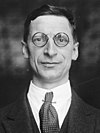Government of the 2nd Dáil
| Government of the 2nd Dáil 3rd Ministry |
|
|---|---|
 |
|
| Date formed | 26 August 1921 |
| Date dissolved | 9 January 1922 |
| People and organisations | |
| Head of government | Éamon de Valera |
| Head of state | President Éamon de Valera |
| Total no. of ministers | 15 (inc. 9 non-members of cabinet) |
| Member party | Sinn Féin |
| Status in legislature | Majority Government |
| History | |
| Election(s) | 1921 general election |
| Legislature term(s) | 2nd Dáil |
| Predecessor | 2nd Ministry |
| Successor | 4th Ministry |
| Government of the 2nd Dáil 4th Ministry |
|
|---|---|
 |
|
| Date formed | 10 January 1922 |
| Date dissolved | 9 September 1922 |
| People and organisations | |
| Head of government | Arthur Griffith |
| Total no. of ministers | 14 (inc. 5 non-members of cabinet & 3 assistant ministers) |
| Member party | Sinn Féin |
| Status in legislature | Majority Government |
| History | |
| Legislature term(s) | 2nd Dáil |
| Predecessor | 3rd Ministry |
| Successor | 1st Provisional Government |
| Government of the 2nd Dáil 1st Provisional Government |
|
|---|---|
 
Michael Collins, W. T. Cosgrave
|
|
| Date formed | 16 January 1922 |
| Date dissolved | 30 August 1922 |
| People and organisations | |
| Head of government |
Michael Collins (Jan.–22 Aug 1922) W. T. Cosgrave (22–30 Aug 1922) |
| Head of state | George V |
| Total no. of ministers | 13 (inc. 4 acting ministers) |
| Member party | Sinn Féin |
| Status in legislature | Majority Government |
| History | |
| Legislature term(s) | 2nd Dáil |
| Predecessor | 4th Ministry |
| Successor | 2nd Provisional Government of Southern Ireland |
The Second Dáil was elected at the 1921 Irish elections on 24 May 1921 and lasted 388 days.
The 3rd Ministry was the Ministry of the Irish Republic that held office from 26 August 1921 – 9 January 1922. It was the appointed soon after the election of the Second Dáil on 24 May 1921.
Contrary to the practice during the first two ministries, when de Valera was re-elected as head of government in 1922 he assumed the title of 'President of the Republic', and therefore explicitly became the republic's head of state, rather than its prime minister. In imitation of the practice in the presidential systems of other nations, the cabinet members of the 3rd Ministry were styled as 'secretaries of state' rather than 'ministers'.
In January 1922 the Anglo-Irish Treaty was ratified and some members, including Éamon de Valera, resigned from the cabinet in protest and were not re-elected.
The 4th Ministry was the Ministry of the Irish Republic that held office from 10 January – 9 September 1922. Following the ratification of the Anglo-Irish Treaty on 7 January 1922, Éamon de Valera resigned in protest and the 3rd Ministry fell. The 4th Ministry, headed by Arthur Griffith, and composed solely of members of the pro-Treaty faction of Sinn Féin, was elected the following day. Six non-cabinet ministers were appointed on 11 January.
Under the terms of the Treaty another cabinet, the Provisional Government, was also established just six days later, under the chairmanship of Michael Collins. The 4th Ministry therefore held office in parallel with the 1st Provisional Government. In August Griffith died of natural causes and Collins was killed in action, however the remaining members of the Ministry remained in office until, on 9 September, the Third Dáil elected a new Ministry under W. T. Cosgrave. Cosgrave took this opportunity to merge the Ministry and the Provisional Government into a single administration, the 2nd Provisional Government. Henceforth the country was governed by only one cabinet.
...
Wikipedia
